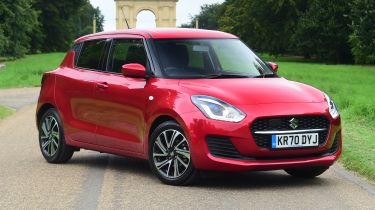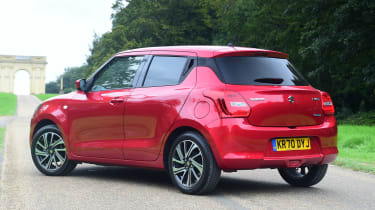Used Suzuki Swift (Mk7 2017-2024) review: a fun, but pricey supermini
A full used buyer’s guide on the Suzuki Swift, covering the Swift Mk7 that was on sale between 2017 and 2024
Verdict
The Suzuki Swift is a likeable car and it’s one that we wouldn’t necessarily steer you away from, but while it offers quite a bit in isolation, when you compare it with its more obvious rivals it’s on shaky ground. As a new buy the Swift is reasonable value, but as a used purchase it can look quite expensive, depending on which model and spec you’re interested in buying. The Sport is a really fun warm hatch, but it’s no class leader, while all Swifts will probably frustrate if you’re intent on doing lots of long-distance motorway journeys. If you do buy one, keep it for more local trips or rural driving where you’ll be able to appreciate the perky engines and brilliantly set-up chassis, along with the compact dimensions that make parking a breeze.
Suzuki recently unveiled an all-new Swift and it’s an incredibly important car for the brand because it sits in a very competitive and crowded segment. With the previous generations notching up nine million sales so far across the world (across eight generations globally), we’re expecting big things of the new model, not least because the outgoing car is a very likeable supermini in many ways.
Used - available now

2019 Suzuki
Swift
45,200 milesManualPetrol1.0L
Cash £9,495
2019 Suzuki
Swift
11,291 milesManualPetrol1.0L
Cash £10,787
2019 Suzuki
Swift
5,470 milesManualPetrol1.2L
Cash £10,787
2019 Suzuki
Swift
29,984 milesManualPetrol1.2L
Cash £9,200But cars in this class today have to be very well rounded, with a wide range of talents, so the big question is whether the current version has what it takes to compete in a large pool of outstanding contenders.
History
Globally there have been eight generations of Swift, including the all-new model that’s due in 2024. However, the variant covered here is the Mk4 in the UK, and it reached dealerships in June 2017 in five-door hatchback form only. Buyers could choose between 89bhp 1.2-litre non-turbo three-cylinder and 110bhp turbocharged 1.0-litre three-cylinder petrol engines, dubbed Dualjet and Boosterjet respectively.
The Boosterjet unit was also available with mild-hybrid tech, called SHVS, which was shorthand for Smart Hybrid Vehicle by Suzuki. A lively 138bhp 1.4-litre Swift Sport joined the range in June 2018, and from spring 2020 this featured hybrid technology to cut fuel consumption and CO2 emissions.
Suzuki facelifted the Swift at the end of 2020, with updated styling for the front, and extra standard equipment for each trim level focusing on enhanced safety kit.
Which one should I buy?
The 1.2 Dualjet engine feels a little lacklustre compared with the turbocharged 1.0-litre, and it came only in entry-level SZ3 (later renamed SZ-L) guise. We’d opt for a 1.0 Boosterjet engine, in mid-range SZ-T or range-topping SZ5 forms. But the most fun Swift of all is the 1.4 Sport, which is an entertaining warm hatchback.
SZ3 trim comes with plastic wheel trims, a DAB radio, Bluetooth, air-con, privacy glass and electric front windows, while the SZ-T adds a rear parking camera, smartphone link and 16-inch alloy wheels. The SZ5 adds navigation, climate control, LED headlights, adaptive cruise control, keyless entry plus auto emergency braking and lane-departure warning. The Sport gets 17-inch alloys, dual exhausts and side skirts; the Attitude special edition featured cosmetic changes only, with no extra standard equipment.
Alternatives to the Suzuki Swift
For the past four years the Ford Fiesta has won the Best Used Supermini gong in our annual awards; before that it was the SEAT Ibiza that took gold. Both make for compelling second-hand buys that are more convincing than the Suzuki, and the same goes for the Skoda Fabia, which is closely related to the SEAT. The Hyundai i20 and Kia Rio are cousins that are also tempting, and so is the Citroen C3, although that car was beaten by the Swift in a 2021 twin test.
The segment wouldn’t be complete without the Vauxhall Corsa or Peugeot 208 with which it shares its platform, while the Toyota Yaris is another strong contender in this class. We’d also urge you to think about the Renault Clio and Mazda 2.
What to look for
4x4
Unusually for this segment, Suzuki offered 4WD with the 1.2 Dualjet engine. It came in manual-gearbox SZ5 form only.
Gearboxes
The 1.0 and 1.2-litre engines were both available with an automatic transmission and with a choice of SZ-T or SZ5 trims.
Wheels
Some Swifts have diamond-cut alloy wheels that can corrode once the lacquer has been attacked by cleaning chemicals or road salt.
Connectivity
Android Auto and Apple CarPlay can disconnect at random times. Software updates and using different smartphones can help.
Reliability
Suzuki generally doesn’t score very well in our brands survey when it appears, perhaps because more mainstream rivals may be better all-rounders. But Suzuki does score well for dependability, which helps to trim running costs.
Interior
One of the key areas in which superminis have come on in leaps and bounds in recent years is interior design and quality. This Swift is much better than before, but it can’t compete with more obvious rivals due to its cheap plastics in places and switchgear that doesn’t feel as durable.
Cabin space is okay, although if there are tall people in the front, adults in the rear will complain of a lack of legroom. There are seatbelts for five. Boot space also trails the class average, at 264 litres with the back seats in use, or 579 litres with them folded down. This could be viewed unfavourably by some people, but the boot remains practical and easy to access.
Prices
There’s no shortage of Swift Mk7s to buy, but they are expensive. There are plenty of automatics for sale, while four-wheel-drive editions are very unusual. The entry-level SZ3 is the rarest trim of all, which is no bad thing; most common is the SZ5.
To check prices on a specific model head over to our valuation tool.
Running costs
All Swifts need to be serviced every 12 months or 12,500 miles, with maintenance alternating between Minor and Major, priced at £202 and £333 respectively. There’s a big service costing £450 due in year six, or at 75,000 miles, when all of the filters and drive belts need to be replaced. That doesn’t include a cambelt, because all Swift engines are chain driven.
The brake fluid has to be replaced every other year and the coolant has to be renewed after eight years or 90,000 miles, but in both cases the cost of this is built into the service. The standard warranty that comes with a new Swift is for three years or 60,000 miles, but owners can extend this cover up to as much as seven years or 100,000 miles at extra cost.
Recalls
Suzuki has a pretty good track record when it comes to issuing recalls, so it comes as no surprise that the Mk7 Swift has been the subject of just two campaigns so far.
The first was issued in June 2019 and it only involved the Swift, but more than 22,000 cars were affected, from the start of production up to February 2019.
The problem centred on side airbags and seatbelt pretensioners activating when they shouldn’t; a software update was required to put things right.
Recall two came in December 2022 and affected 71,508 Swift, Baleno, Vitara and S-Cross models. Some cars built between October 2017 and June 2019 were fitted with faulty brake servos, which could lead to the brake assistance failing, but not the brakes altogether. The fix was to fit a new valve in the servo.
Driver Power owner satisfaction
The Swift hasn’t appeared in any Driver Power surveys, and, apart from the Vitara, the brand rarely shows up. The Vitara tends to get mid-table scores; in recent years it has peaked in 46th place and dropped as low as 54th. Suzuki came 28th in the 2022 brands survey and managed only 26th in 2023. First place for value and seventh for running costs were impressive, but the overall quality got a thumbs down.
Looking to sell your current car quickly and for a good price? Get offers from top dealers with our Sell My Car service









